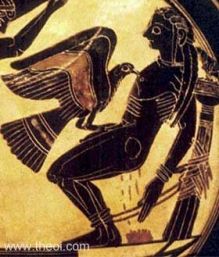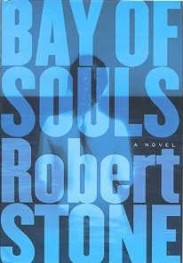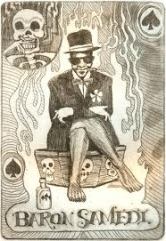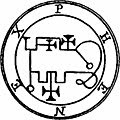Does a watch, found on a beach somewhere, make it reasonable to assume the existence of a watch-maker? This question is familiar to those immersed in philosophy of religion and the works of writers like Pascal and William James. This is the question taken up appropriately in our era by a science-fiction film. And it alludes to the long tradition of dealing with this kind of question in myth, drama, and novels by having the title Prometheus.
The “watch” for the film is the awe-inspiring sequence of vistas that we find ourselves confronted with over the course of our lives. The visions we encounter, like the opening sequences of mountains and a chalky cataract plunging over cliffs into a river below, instill in us a naïve theological argument. These kinds of powerful images are used over and over again in the narrative of Prometheus. They range from light and water, sun and sky and starlight imagery – the Apollonian – that preoccupy the early parts of the movie, together with the Dionysian descents in chasms, haunting visages, shadowy domes that fill the latter half of the movie. It is the feelings inspired by visions that give cogency to the otherwise shallow words uttered twice by two of the less-than-memorable characters who populate Prometheus: “I believe because I choose to.”
The impressive influence that comes over us by way of our visual cortex can’t be underestimated as one of the main bases for religion. It must be true that susceptibility to this influence must vary from person to person, although the popularity of film generally suggests a basically high level. So for a person like Scott, an artist who consumer culture has catapulted to the ranks for genius, the visual must play an important role in his life of mind and life of belief. Like the Methuselahesque Weyland, Scott has spent his life a builder of worlds. The scenery in the background of his holographic speech to the crew, reminds one of the cityscape of Blade Runner or even, more loosely, the cityscape of ancient Rome conjured up in Gladiator.
Prometheus was for the Greeks a god who had fallen into disfavor. Folk etymology explained his name as meaning “wise before the deed” but in fact his name meant something else in a language everyone had forgotten. He is given the status therefore of Titan, probably because his cult was superseded by later the cult of the Olympians. Accordingly, the important myth in which Prometheus is featured has him chained up by Zeus, confined to the eternal punishment of having his innards pecked out by omnipresent vultures. And so although this story was unlikely to be intended as such, Prometheus was fit into the pattern of the hero-savior, who sacrifices himself for humanity.
For the film this myth is central. It serves as a prologue to the story in much the same way the monolith and gibbering Neanderthals set the premise for 2001: A Space Odyssey. Notice the ritualistic elements in the sequence. The Engineer climbs to the top of a tall mountain just as his UFO vanishes into the sky. This represents his abandonment to his fate, his absolute commitment. He then sheds what looks like some kind of monastic robe. The choice of making him look like not only a cenobite of some kind, but also a martial artist, is telling. Notice also that he takes the mutagen serum in what can only be a ritualistic gesture. It isn’t injected or swallowed in a gel cap. Rather he drinks it back like a sacrament. And thereby he literally fulfills the words of the mass giving up his body so sins may be forgiven. To understand the meaning of the prologue as a sacrifice requires some further speculation, imaginative speculation, about what the greater purpose of what may be ultimate design of the Engineers in Prometheus.
The Engineers were likely advanced enough to have seeded the earth with life without requiring the actual destruction of one of their numbers. That one of their numbers would actually give of his life for this purpose indicates that there is some kind of non-utilitarian belief system at work – Weyland similarly found it desirable to bring along on the expedition the two scientists who discovered the star-map. We could also reasonably speculate that not just anyone is chosen for the honour of seeding a new planet with what will ultimately become sentient life. In fact it is precisely this kind of altruism, this kind of willingness to face extinction in the name of the greater cause that made the Engineer eligible for the service. The Engineers probably revere to the point of worship the DNA code and the humanoid form it gives rise to.
Evidence from the film suggests that the Engineers are a phenomenally old species. They are engaged in a project that is just about beyond human comprehension. What can be said about it is that they are deliberately trying to force the evolution of their genetic data.
What the Engineers had probably found early on in their existence was that there is an inherent contradiction in life. It has to destroy in order to survive. But ultimately, survival of sentient life forms depends on overcoming this tendency to want to destroy. And so a bloody epic unfolds in which a species grapples with itself, with periods of stability followed by times of conflict that come very close to bringing about utter annihilation. The Engineers found experiments in both nature and nurture both to be powerless to overcome the destructive impulse. And yet, gripped by a non-rational impulse, they focused all the energies of their powerful civilization on filling the universe with their life. They did this in the hopes that one form of life would undergo some random mutation that would succeed at last in resolving the contradiction that had plagued the existence of their species. This project was made possible by a singular discovery, the mutagen agent that we see in urns on the buried UFO that the crew of the Prometheus discovered. This agent caused massively rapid and random mutations. When mixed with the existing DNA code of a living host it unleashes possible variations. It is very possible also that some degree of disciplined control on the part of the Engineer who imbibed the mutagen went into unleashing its potentiality as the genetic basis for all the life of a planet. Otherwise, however, if randomly spilled on the ground or slipped into a mickey or fallen into face first, it is likely to produce some hostile result. Hence the possession and spawning of monsters that leads to so much trouble throughout the film.
And yet, the behavior of the only Engineer to be met in the film would seem to contradict the thesis that they were a race of Utopians, trying to seek Enlightenment through the perfection of an ultimate species. Certainly their ship, the weird gothic interiors and the fact that the only decoration was a huge statue of the Engineers themselves all seem to suggest that they were in fact a destructive and hostile species. This fits with the idea that they created the mutagen and the H.R. Giger-alien species as a weapon or maybe just for kicks. But here the supposition is that they are static. Remember hundreds of millions of years, if not billions of years, intervened into the life of this race. Though powerful, they aren’t necessarily unchanging. What is very likely is that over time their religion came to be corrupted. That is, they stopped finding meaning in the forward-looking project of creating some perfect form of life and instead decided to glorify themselves – perhaps by seeking a form of eternal life. This would have been seen as a heretical development to the original Engineer faith, which viewed life as a perpetual process of change and mutation. And so a war ensued between a faction that we’ll call the Narcissists and a faction that might be designated the Heraclitians. It was a holograph of this war that the android David found when he accessed the Engineer’s computer in the corridor. And then, perhaps to wait out the infection they had unleashed against their enemies, the remaining Narcissist Engineers when into a long sleep. During this time knowledge of the earth was forgotten about, giving our species the time it needed to evolve at least to the point where we could follow the clues they had left us.
There is a very good chance that our species is coming very close to developing along the lines that the original faith that the Hericlitians had hoped for or prophesied. Indeed there was a hope of reconciliation and acknowledgement that Weyland had dreamed of. This was the paternal fantasy that had long lured humankind into folly. The moment occurred when the alien listened to David speaking to some ingenious reproduction of its speech. What David and the others could not have fathomed is that the Engineer view them all with contempt and very possibly as aberrations against itself. Perhaps they would have had a chance to communicate with it if they came as supplicants. But even then, there is little chance the Engineer would have thought twice before destroying them and then wiping out the human race – effacing all signs of its rival faction’s sentimentality.
This was not a good movie. Ridley Scott (he will never earn the distinction of being just “Scott”) is no Kubrick. He has far more in common with John Carpenter, when all is said and done. Of course the movie has a lot of interest-value and is worth the entertainment a few hours and a few dollars can provide. Then again, the same can be said of the titanically stupid Battleship. Things exploded, some weird sounding guns got fired, etc. And yet, Ridley Scott can film some stately sequences. There are beautiful and haunting spaceship aesthetics – especially when the spaceship Prometheus alights on the planet surface – that conjure up the beauty of 2001: A Space Odyssey – all the classical music and a computer voice calling someone David served as some pretty heavy-handed allusions, (It is generally agreed that David is the most compelling character in the film). There are neat effects like the “pups” that map the inside of the Engineers catacomb. And everyone agrees that the caesarian section sequence was a unique and harrowing event. But it was all stitched together poorly. The first few prologues to the space voyage hinted that the sequence of the whole film was wonky. This off-kilter sequencing meant that otherwise decent performances by all the cast made their behavior seem illogical. What slit the movie’s throat was the dialogue. Who thought it would be successful to let the writer of “Lost”, for heaven’s sake, get behind the wheel of a script for a serious feature length film? He succeeded in making the characters of Prometheus all sound like morons – like something between the cast of “Friends” and a Tarantino film all launched into intergalactic space. This is what happens when pretentious and mediocre nonsense like “Lost” gets undeserved praise: those associated with it go on to ruin films that might otherwise have had potential to be at least cult classics.









 Bibliophilia Obscura
Bibliophilia Obscura Goodreads
Goodreads The Modern Word
The Modern Word